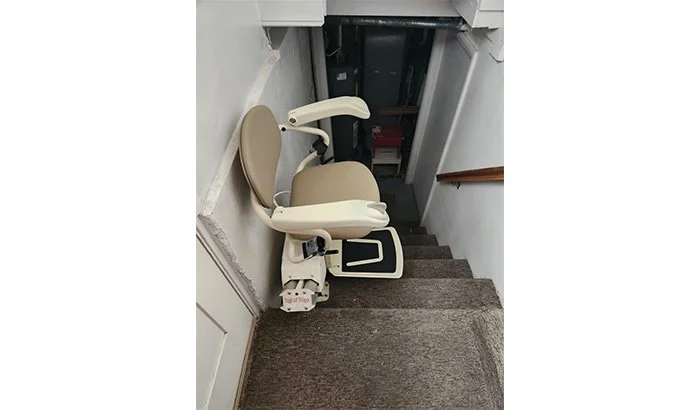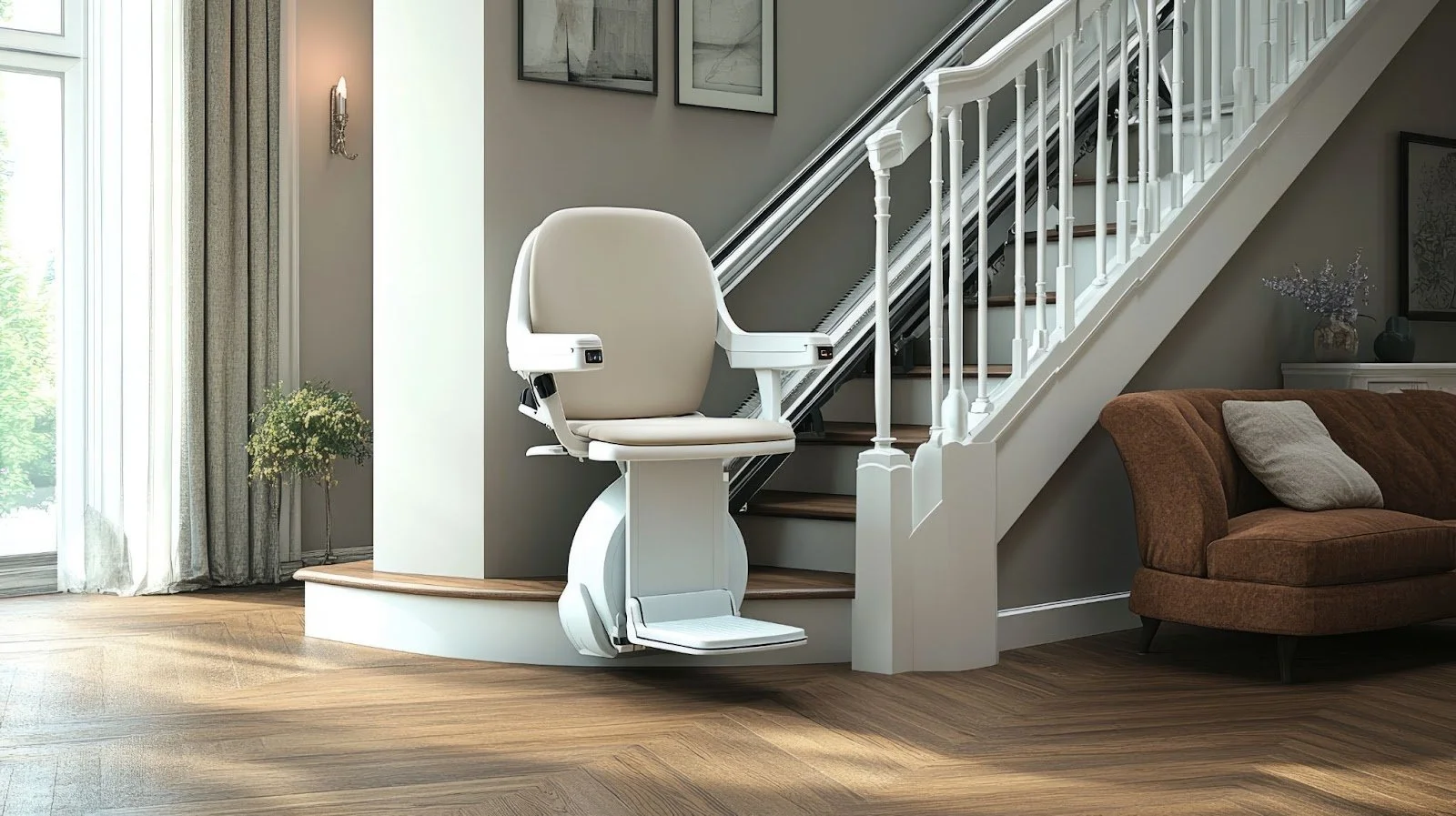Curved Rail Stairlifts vs. Straight Rail Stairlifts: Pros and Cons
Choosing the right stairlift for your home means considering its unique layout. Curved stairlifts are often the go-to option for homes with spiraled or uniquely shaped staircases.
On the other hand, straight rail stairlifts suit the straightforward, unobstructed paths found in many homes. This distinction might seem simple, but the implications for daily living are profound.
Deciding between a curved or straight stairlift involves more than comparing price tags; it's about matching the solution to your needs. Does your staircase make sharp turns or feature multiple landings?
Or is it a single, straight shot from one floor to the next? Each scenario demands a tailored approach to ensure safe, comfortable navigation of your living spaces.
This discussion isn't only about functionality — it's also about reclaiming independence and enhancing safety in your home. Whether you prefer the bespoke design of curved stairlifts or the straightforward simplicity of straight models, understanding the pros and cons of each will empower you to make the best choice for your home and lifestyle.
Understanding the basics
Straight lifts are the most common choice for homes with a simple, straight staircase without any bends or landings. These stairlifts run along a single straight rail that installers can fit quickly and with minimal disruption to your home.
Conversely, curved lifts are necessary for staircases with turns, bends, or intermediate landings. The rails for curved lifts require custom fabrication to ensure they fit the staircase's unique contours.
Pros of straight rail stairlifts
Cost-Effective Straight rail stairlifts generally cost less than their curved counterparts. The lower cost stems from the standardization of the rails and the less complex manufacturing and stairlift installation process. This makes straight rail stairlifts a more budget-friendly option for those who need stairlift assistance without a significant financial burden.
Ease of Installation Stairlift installation for straight rail models is typically straightforward, often taking only a few hours. This quick installation means less disruption in your home and quicker access to the stairlift's benefits.
Availability Due to their common design, straight rail lifts are widely available and often ready for immediate stairlift installation. This availability is paramount for individuals who need mobility assistance on a short timeline.
Cons of straight rail stairlifts
Limited Flexibility Straight rail stairlifts only work on completely straight staircases. They offer no flexibility for homes with stairs that feature bends, curves, or multiple landings, limiting their application in many homes.
Resale Challenges Because designers create straight rail stairlifts for standard staircases, they might not fit in another home with different stair dimensions or configurations, making them difficult to sell or transfer.
Pros of curved stairlifts
Customization Curved stairlifts are custom-built to fit the exact specifications of your staircase, whether it features bends, curves, or multiple levels. This customization ensures a perfect fit and optimal functionality throughout the entire length of the stairs.
Versatility Curved stairlifts can navigate multiple flights of stairs, making them ideal for homes with complex staircase designs. This versatility makes them suitable for virtually any home layout.
Enhanced Aesthetics Since manufacturers tailor curved stairlifts for each home, they often blend better with the home's decor, offering a more integrated appearance than straight rail lifts.
Cons of curved stairlifts
Higher Cost The custom nature of curved lifts typically makes them more expensive. The cost includes the materials, custom manufacturing, and a more complex stairlift installation process.
Longer Installation Time Because each curved stairlift requires a unique rail, the production and installation process takes longer. This extended timeframe might be inconvenient for those who need immediate assistance.
Complexity in Repairs and Maintenance The bespoke design of curved stairlifts also complicates repairs and maintenance. Finding replacement parts or services can be more challenging and potentially more costly than for straight rail stairlifts.
Making the right choice
Choosing between curved stairlifts and straight rail stairlifts ultimately depends on your specific staircase layout and personal needs. If your home has a straight staircase, a straight rail stairlift will likely meet your needs efficiently and cost-effectively.
However, if your home features a staircase with bends, curves, or multiple landings, a curved stairlift will provide the necessary flexibility and customization.
Consider the long-term
It's also important to consider the long-term implications of your choice. While straight rail stairlifts may seem economically advantageous now, curved lifts could offer better long-term functionality and comfort. It depends on your home's architecture. Assess both the immediate and future benefits of each option before making a decision.
Final thoughts
As we wrap up our exploration of curved stairlifts and straight rail lifts, remember that your choice should reflect your home's layout and your personal mobility needs.
While curved stairlifts offer custom solutions for complex staircases, straight rail lifts provide a practical, cost-effective option for simpler setups. Each type has its strengths and will significantly improve your home's accessibility and independence.
Consider how the stairlift will fit into your daily life. A well-chosen stairlift improves safety and seamlessly complements your home's aesthetics, preserving the comfort and character of your living space.
Consider the long-term benefits and choose a model that will serve you reliably for years to come, adapting as your needs evolve. Investing in a stairlift is about more than mobility; it's about enhancing your quality of life at home.
Whether you opt for the tailored design of a curved stairlift or the straightforward efficiency of a straight rail stairlift, you are taking a step toward safer, more comfortable living. Equip your home with the tool that best suits your staircase, and enjoy the peace of mind and independence that comes with it.
Check out Salt Lake Stairlifts for all your stairlift needs
When contemplating home upgrades, a home lift solution like stairlifts or wheelchair lifts is often overlooked. Yet these installations are not mere luxuries; they embody practicality and significantly enhance the quality of life.
For households facing mobility challenges or those with multiple floors, such solutions redefine daily living by making every level of the home accessible and safe. Imagine the sense of freedom and relief that comes with the assurance that every floor in your home is within reach, without the fear or physical strain of navigating stairs.
Whether it involves carrying laundry to the basement or reaching an upstairs bedroom, mobility aids like stairlifts and wheelchair lifts offer invaluable assistance. This independence proves especially vital for individuals wishing to age in place or for families caring for elderly relatives or members with disabilities.
The advantages of incorporating a home lift system extend beyond personal convenience and safety. They represent a wise financial decision, enhancing your property's market appeal and value.
In a housing market where accessible features distinguish a home, installations like these ensure your property stands out to a broader audience, appealing to buyers seeking a long-term residence adaptable to all stages of life and varying abilities.



